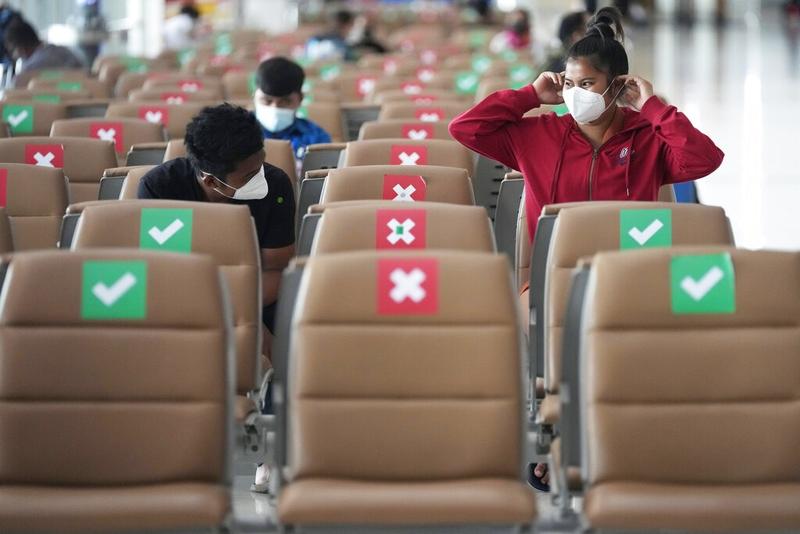 Passengers sit spaced apart while wearing face masks to help curb the spread of the coronavirus at Suvarnabhumi airport in Bangkok, Thailand, July 21, 2021. (SAKCHAI LALIT / AP)
Passengers sit spaced apart while wearing face masks to help curb the spread of the coronavirus at Suvarnabhumi airport in Bangkok, Thailand, July 21, 2021. (SAKCHAI LALIT / AP)
With Thailand welcoming back foreign tourists to select destinations, Ulas Mehmet Isci is cautiously optimistic that his tourism business will finally recover after it came to a standstill since early 2020 in the wake of the pandemic.
“We really hope that tourism is going to come back in the (next) five to six months”, or perhaps over the coming year, said Isci, CEO of Tropics Travel, which operates multiple travel agencies across Thailand including Koh Samui Tours, Chiang Mai Tours, Phuket Tours and Krabi Tours.
“I see a sign of recovery, but the recovery might come … a little slow,” Isci told China Daily. His business, which has seen tourist numbers sometimes plummet to zero over the past year, has only recovered by about three to five percent after Thailand rolled out its reopening programs this month.
Following the “Sandbox” program that began allowing vaccinated foreign tourists into the resort island of Phuket from July 1, Thailand launched a similar scheme called Samui Plus on July 15 to enable travel to Koh Samui — the country’s second largest island after Phuket — via direct international flights or via sealed routes from Bangkok.
The new program requires tourists to stay at an approved hotel in Koh Samui for a week and stay within their accommodation for the first three days, according to the Tourism Authority of Thailand, or TAT.
With a negative COVID-19 test, the tourists will be allowed to travel to the neighboring islands of Koh Tao and Koh Phangan after their first week on Samui.
Thai Minister of Tourism and Sports Phiphat Ratchakitprakarn said the reopening of the three islands under the Samui Plus program is another significant step toward achieving the goal set by Prime Minister Prayut Chan-o-cha in mid-June to reopen the whole country within 120 days, or by the end of October.
“Phuket is already open as the pilot destination, and other destinations will follow in the scheduled order with carefully planned disease control and public health measures, travel procedures, and the right tourism marketing all being addressed,” said Phiphat.
The TAT expects the number of tourists to arrive under Samui Plus to reach a thousand in the first month and generate 180 million baht (US$5.48 million) for the local economy.
But unlike Phuket, which has seen some 5,000 foreign tourists between July 1 and 15, Koh Samui had a quiet reopening with only about 10 media members visiting the island on the first day, Bangkok Post reported.
The opening-up of more islands came even as Thailand has been witnessing a rising number of COVID-19 infections over the past few weeks.
Mainly driven by the highly contagious Delta variant of the virus that was first detected in India, Thailand recorded more than 8,000 daily cases for twelve consecutive days as of July 20.
The Southeast Asian country reported a daily record of 11,305 new COVID-19 cases on July 20, bringing the national caseload to 426,475, according to data released by Thailand’s health ministry.
“There is a significant risk in the Thai approach to reopening given cases are not just increasing across the country but increasing aggressively,” said Jeremy Lim, associate professor and director of global health at the National University of Singapore’s Saw Swee Hock School of Public Health.
Lim told China Daily that Thailand is far from achieving the necessary levels of vaccination, a key to successful reopening.
By July 20, Thailand had administered 14.55 million doses of COVID-19 vaccines after it started a vaccination campaign in February.
In order to realize its reopening plan, Thailand needs to have a threshold of 50 million people given first shots by early October.
“If new vaccination supplies can be procured and vaccination ramped up quickly enough, there is a sliver of hope that Thailand can meet its set timelines,” said Lim, adding that Thailand’s experience can provide useful lessons for all countries.
Bill Barnett, managing director of hospitality consultancy C9 Hotelworks in Thailand, said he is still “cautiously positive” about Thailand’s reopening, given that only ten people tested positive among about 5,473 travelers arriving in Phuket in the first two weeks.
“If they didn’t catch anybody with COVID-19, it’s probably not going to be realistic,” Barnett said.
The next destinations to reopen — on Sept 1 — will be some designated areas in provinces including Krabi, Phang Nga, Chiang Mai, Chon Buri, and Buri Ram.
The scheduled date for the reopening of Bangkok, Cha-am in Phetchaburi province and Hua Hin in Prachuap Khiri Khan province is Oct 1,
with the rest of Thailand due to reopen throughout October, according to the TAT.
Barnett said he does not expect to see the reopening program having a large impact before October, until the “snowbirds”, or travelers from colder areas, start to arrive for holidays.
Still, he said the demand is clear, as nearly 200,000 room nights have been booked through the end of August in Phuket.
“The Sandbox alone isn’t going to save Thai tourism but (it will demonstrate) the power to influence and show other destinations what could be done … that’s probably going to (have) more lasting impact than just a single thing,” said Barnett.
For tourism agency owner Isci, after surviving the devastating hit caused by the pandemic, all that he and his business can do, meanwhile, is prepare and hope for the best — that more tourists will start flying in, albeit gradually.
Tourism flows will depend on the progress of vaccination campaigns in Thailand as well as in other countries, he said.


